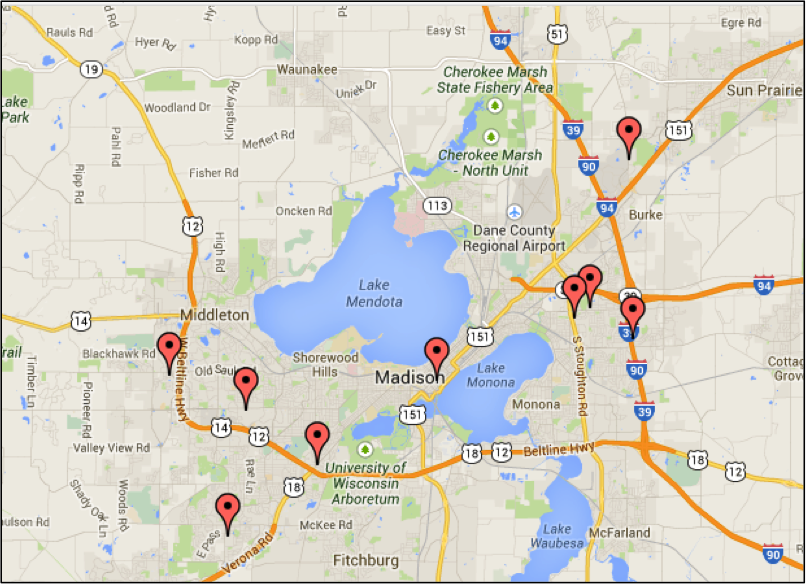Problem Description
Recently, University of Wisconsin (UW) Health has been working on an initiative to reduced patient hospital readmissions. Through extensive data analysis, it was concluded that the elderly population has a higher chance of readmission. Data shows that the majority of all elderly patient readmissions occur within the first week after being discharged from the hospital. In an attempt to reduce readmissions for this population, UW Health has invested in a unique program to hire nurse practitioners (NP) to visit patients in skilled nursing facilities and provided appropriate follow-up care as needed.
Since it is critical to visit all patients that are discharged to the nursing facilities, UW Health must ensure that the optimal number of nurse practitioners is hired. Under the transitional care program, there are nine facilities in the Dane County area where the nurse practitioners would be stationed, with a total of 815 beds. Each facility is privately run and has a unique number of beds. The figure below shows the locations of the facilities. The driving distance between the locations is listed in the table.

| Distance (mi) | Capital Lakes | Karmenta | Oakwood West | Oakwood East | Sunny Hill | Attic Angels | St. Mary’s | Oak Park | Belmont |
|---|---|---|---|---|---|---|---|---|---|
| Capitol Lakes | 5.2 | 6.4 | 8.8 | 5.6 | 10.9 | 8.9 | 7 | 5 | |
| Karmenta | 5.2 | 15.8 | 5.5 | 11.9 | 17.2 | 15.2 | 2.6 | 0.5 | |
| Oakwood West | 6.4 | 15.8 | 20.9 | 3.4 | 3.4 | 5.4 | 15.5 | 14.6 | |
| Oakwood East | 8.8 | 5.5 | 20.9 | 17.4 | 22.7 | 20.7 | 7 | 5.5 | |
| Sunny Hill | 5.6 | 11.9 | 3.4 | 17.4 | 6 | 3.9 | 13 | 12.1 | |
| Attic Angels | 10.9 | 17.2 | 3.4 | 22.7 | 6 | 6.3 | 17.9 | 17 | |
| St. Mary’s | 8.9 | 15.2 | 5.4 | 20.7 | 3.9 | 6.3 | 15.9 | 15 | |
| Oak Park | 7 | 2.6 | 15.5 | 7 | 13 | 17.9 | 15.9 | 2.9 | |
| Belmont | 5 | 0.5 | 14.6 | 5.5 | 12.1 | 17 | 15 | 2.9 |
Under this program, a nurse practitioner is stationed at a specific facility. We define our optimization problem to determine the minimum number of nurse practitioners needed to maximize the number of patients that are within a three-mile radius of a facility that has a stationed nurse practitioner.
To model this problem, several assumptions are made: (1) each nurse practitioner works at the same pace and can visit the same number of patients, and (2) only distance between locations, not travel time, is considered.
Model Description
We describe components of the model below.
- Let \(NP\) denote the number of nurse practitioners
- Let \(Z\) denote the number of patients covered by a nurse practitioner
- Each nursing facility is assigned an integer ID,
SNF\(= 1, 2, \ldots, 9\) - A binary variable \(X(i) = 1\) if a nurse practitioner is stationed at facility i, otherwise \(X(i) = 0\)
distance(i,j)denotes the driving distance between facility \(i\) and \(j\)cover(i,j)\( = 1\) ifdistance(i,j)\( < 3\); i.e., that a facility is covered by a nurse practitioner who is within 3 miles of the facilitypatients(i)denotes the number of beds at facility \(i\)
Given the number of nurse practitioners, the objective of the problem is to maximize \(Z\), which is defined as \(Z := \sum_{i,j} patients(j) * x(i)\). The model is subject to the following constraints: (1) \(\sum_i x(i) = NP\) and (2) that each nurse practitioner is stationed at only one facility at a time.
Solving the problem
Below is a demo of the nurse staffing optimization problem. The number of patients covered is maximized given the number of nurse practitioners available.
| Enter your email address: | Select the number of nurse practitioners: |
|
| Job number and password: | Patients served: |
Results
This study analyzed results for nine models, one for each different number of practitioner. Results are listed in the following table:
| Number of nurses | Number of patients served |
|---|---|
| 1 | 418 |
| 2 | 523 |
| 3 | 618 |
| 4 | 705 |
| 5 | 773 |
| 6 | 815 |
| 7 | 815 |
| 8 | 815 |
| 9 | 815 |
It is clear that the maximum number of patients is reached when at least six nurse practitioners are hired. When the program has six nurse practitioners, they will be stationed at the following facilities: Capitol Lakes, Karmenta, Oakwood West, Oakwood East, Sunny Hill, and St. Mary’s

